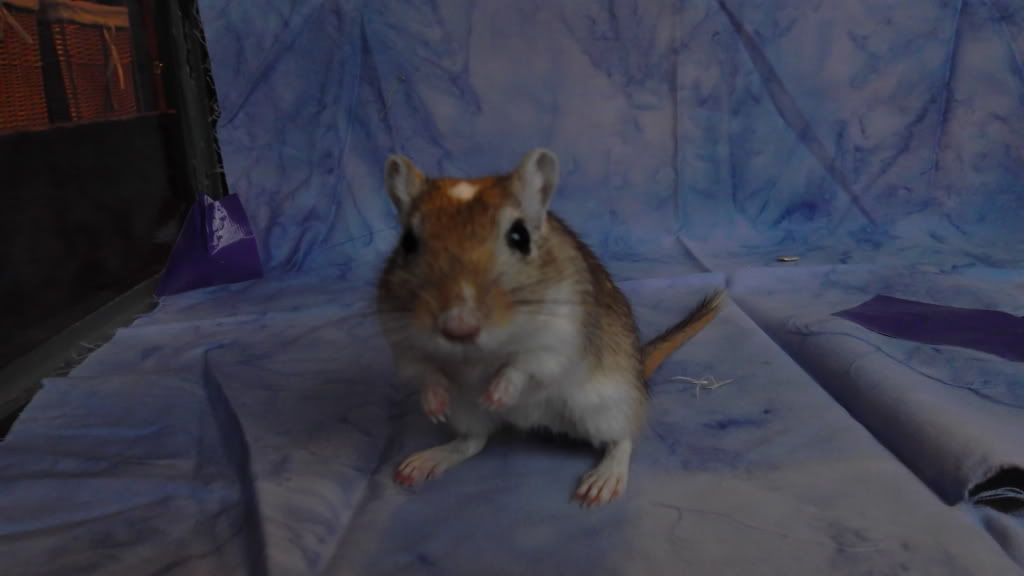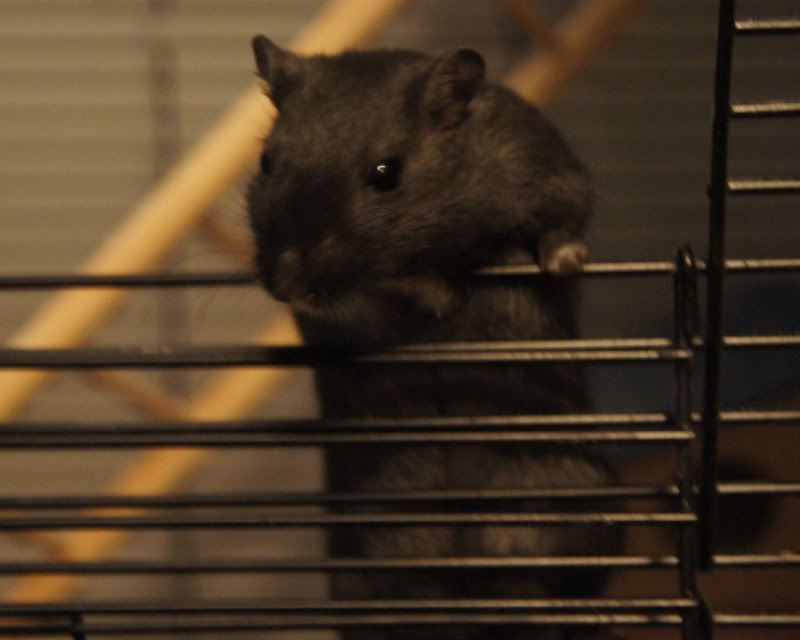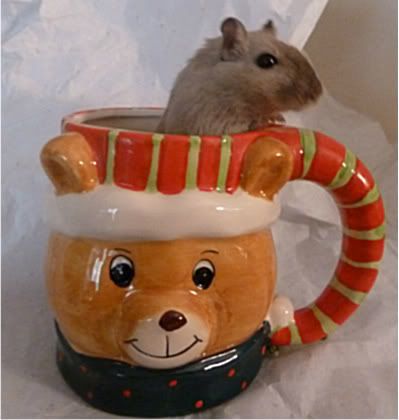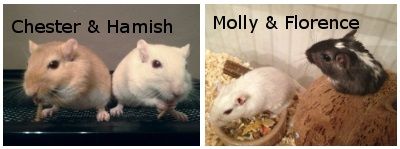Post by MoonstoneGerbils on Feb 23, 2012 20:26:09 GMT -8
NOTICE:
If you are interested in judging please pm moonstonegerbils
Rules:
Photographs must be taken between date of announcement and the dead line for that gerbil’s class.
You may enter up to 8 gerbils. Limit of 3 gerbils per class and no more than two of one color.
You may only enter gerbils that you own.
Minimum Class Size
A minimum of 5 entries is needed for each class, if the minimum is not met the deadline will be extended.
If more than 10 entries are in a class, the class will be split by the judge as s/he sees fit.
Gerbils must be at least 6 weeks old to compete. A senior class and pup class will be created if there are enough entries. Pups are between 42 and 90 days old, senior is 2.5years or older. Pups and Seniors may be entered at anytime before the last deadline. In order for a pup or senior to compete in both their age class and their color class they must be entered into their color class by the appropriate deadline.
Gerbils will be judged based on the AGS standards. Gerbils that do not meet a standard written by the AGS may still compete (ie. Topaz, Sapphire, and light color points)
The points are allotted accordingly:
30pnts for Conformation
(6 points for head shape)
(6 points for build)
(4 points for tail)
(3 points for shoulders)
(3 points for whiskers)
(3 points for ears)
(2 points for toes)
(2 points for eye shape)
(1 points for tuft)
30pnts for Color
40pnts for preparing and photographing gerbils.
(10 points for relaxed gerbil)
(10 points for profile photo)
(10 points for portrait photo)
(10 points for background choice)
People's Choice
There will be a people’s choice for each class, voting will be done anonymously by polling. Limit of one vote per member, and you may not vote for your own gerbil or solicit votes from other members. The voting period will last for two weeks, at which time the People's Choice award and the results for the class will be announced.
Classes:[/u][/size]
Colorpoint/Other ]Deadline May 31st
Burmese, Siamese, CP Agouti, CP Nutmeg, CP Silver Nutmeg, CP Gray Agouti, CP Slate, DTW, Schimmel, Champagne, Silver Point, Honey Cream
Marked Deadline May 31st
Spot, Pied, or Mottled for any color.
White Belly Deadline May 31st
Agouti, DEH, Gray Agouti, Polar Fox, Argente, Argente Cream, Yellow Fox, Apricot, other white belly colors not listed may be entered.
Self Deadline May 31st
Black, Nutmeg, Slate, Silver Nutmeg, Lilac, Dove, Red Fox, REW, PEW, BEW, Blue, other self colors may be entered.
Pups/Seniors Deadline May 31st
To Enter a Gerbil:
Do not crop or edit picture.
Provide the following information for each gerbil:
Your Gerbil Forum Screen Name:
Gerbil’s Name:
Gerbil’s Gender:
Gerbil’s Age (guessing is ok):
Gerbil’s Color:
Where was Gerbil adopted from (Pet Store/Rescue/Breeder)?:
Send photos and Gerbil Information to Katie at virtual@moonstonegerbils.com be sure to write the class in the subject box. Attach the photo as a file, or send a link to gerbil’s photo if it is hosted on a website.
Prepare the Gerbil:
Gerbils will need a sand bath before taking the pictures. This will smooth their fur and should eliminate any matting especially around the shoulders. Decide where you will be taking pictures and allow your gerbils to become familiar with this area. The more familiar they are with the area the less time they will spend scent marking and exploring. Also they should be used to the sounds and lights of a camera makes.
This gerbil is greasy and needs a sand bath.

Camera Settings
Take lots of photos but don't be surprised if it takes 20 or more pictures before you find the right shot.
Make sure to turn off “red-eye” features on your camera.
Set your camera to either a macro setting if taking pictures up close.
Using burst mode or the sports/action modes may help capture pictures.
If you use flash photography be sure to take them from a distance to reduce glare. If you aren't using flash, you need to make sure there is ALOT of light in the room.
Some cameras allow you to choose a shutter speed, exposure time, or other advanced settings. Learning how to use these features can make picture taking easier in bright and dim lighting.
Choosing the “Photo Booth”
In order to achieve the best photo quality takes pictures in well lit areas. Flash photography can cause the gerbils to look discolored; this can be especially problematic on some of the pastel colors.
Select a background that contrasts with the color of your gerbil and is plain. Choose simple backgrounds that only have one or two colors, avoid taking photos of gerbils in their cages or on their bedding. Light colored gerbils should be photographed on dark background, and dark colored gerbils should be photographed on light backgrounds. Marked gerbils like spotted, pied, or mottled should be taken on a background that is distinct from both their colored and marked areas. Be aware that the color of the background may cause your gerbil to take on slightly different tones; this can both help and hinder you.
This light colored gerbil is on a dark background making it very easy to look at the gerbil.

This background is almost the same color as the gerbil.

This background is very busy and distracts the judge from the gerbil.

Profile pictures:
A profile picture should show the entire gerbil from head to tail. Their tail should be straight behind them, it is best to take the photo perpendicular to the gerbil. Only one eye should be visible. The judge will be looking at the conformation of the body, especially the length of the body and shape of the spine. Taking pictures of gerbils at an angle may cause the tail to seem shorter or longer than it truly is. The best pose is with 3 or 4 feet on the ground, and not hunched. Using treats to bribe your gerbil to sit still will often cause them to hunch over and eat, which is not the correct position. Avoid picking photos where gerbils are sniffing, scent marking, or standing on two feet.
This is an example of good posture.

This gerbil's picture was taken at an angle and his tail curves away from the photo making it appear short. His tail and tuft are not in focus and can not be judged. Otherwise he has good posture.

This gerbil is hunched over, standing on two feet, and both his eyes are visible. He's a nice gerbil, but it would be easier to see that if he was in a better position.

Portrait Pictures:
Portraits must show both eyes, and are best taken slightly to the left or right of the gerbil. Pictures should be level with the gerbils and the s/he should be looking at the camera. Pictures where the gerbil is looking down or up are not ideal. Judges are looking at whiskers, eyes, and ears in this picture so be sure they are in focus.
This is a good example of a portrait, the face, whickers, eyes and ears are in focus and the gerbil is looking at the camera.

A good example, but a little blurry.

This view is a little too far to the side, if the head was turned a little more to center it would be a great picture.

Although this image is looking down at the gerbil, he is looking at the camera.

This gerbil is looking downwards. Making it difficult to see his face.

Tips and Tricks
Make sure to select photos where the ears are relaxed and facing either out or forward. A gerbil that is pinching their ears, holding them back, or laying them flat to their head may appear to be nervous.

Only choose photos where the gerbil is in focus. Blurry pictures are harder to judge.
Stairs make a great place to photograph gerbils, as it gives them a long and narrow area to run back and forth, making it easier to take profile photos.
Use the same “photo booth” for both the profile and portrait for consistency.
Remember a judge can only judge what they can see, gerbils that are blurry, pixelated, or out of frame will lose points for what can not be seen.
Also, all mongolian gerbils are welcome to participate, this is a friendly competition with an emphasis on gerbils as pets and companions.
If you are interested in judging please pm moonstonegerbils
Rules:
Photographs must be taken between date of announcement and the dead line for that gerbil’s class.
You may enter up to 8 gerbils. Limit of 3 gerbils per class and no more than two of one color.
You may only enter gerbils that you own.
Minimum Class Size
A minimum of 5 entries is needed for each class, if the minimum is not met the deadline will be extended.
If more than 10 entries are in a class, the class will be split by the judge as s/he sees fit.
Gerbils must be at least 6 weeks old to compete. A senior class and pup class will be created if there are enough entries. Pups are between 42 and 90 days old, senior is 2.5years or older. Pups and Seniors may be entered at anytime before the last deadline. In order for a pup or senior to compete in both their age class and their color class they must be entered into their color class by the appropriate deadline.
Gerbils will be judged based on the AGS standards. Gerbils that do not meet a standard written by the AGS may still compete (ie. Topaz, Sapphire, and light color points)
The points are allotted accordingly:
30pnts for Conformation
(6 points for head shape)
(6 points for build)
(4 points for tail)
(3 points for shoulders)
(3 points for whiskers)
(3 points for ears)
(2 points for toes)
(2 points for eye shape)
(1 points for tuft)
30pnts for Color
40pnts for preparing and photographing gerbils.
(10 points for relaxed gerbil)
(10 points for profile photo)
(10 points for portrait photo)
(10 points for background choice)
People's Choice
There will be a people’s choice for each class, voting will be done anonymously by polling. Limit of one vote per member, and you may not vote for your own gerbil or solicit votes from other members. The voting period will last for two weeks, at which time the People's Choice award and the results for the class will be announced.
Classes:[/u][/size]
Colorpoint/Other ]Deadline May 31st
Burmese, Siamese, CP Agouti, CP Nutmeg, CP Silver Nutmeg, CP Gray Agouti, CP Slate, DTW, Schimmel, Champagne, Silver Point, Honey Cream
Marked Deadline May 31st
Spot, Pied, or Mottled for any color.
White Belly Deadline May 31st
Agouti, DEH, Gray Agouti, Polar Fox, Argente, Argente Cream, Yellow Fox, Apricot, other white belly colors not listed may be entered.
Self Deadline May 31st
Black, Nutmeg, Slate, Silver Nutmeg, Lilac, Dove, Red Fox, REW, PEW, BEW, Blue, other self colors may be entered.
Pups/Seniors Deadline May 31st
To Enter a Gerbil:
Do not crop or edit picture.
Provide the following information for each gerbil:
Your Gerbil Forum Screen Name:
Gerbil’s Name:
Gerbil’s Gender:
Gerbil’s Age (guessing is ok):
Gerbil’s Color:
Where was Gerbil adopted from (Pet Store/Rescue/Breeder)?:
Send photos and Gerbil Information to Katie at virtual@moonstonegerbils.com be sure to write the class in the subject box. Attach the photo as a file, or send a link to gerbil’s photo if it is hosted on a website.
Prepare the Gerbil:
Gerbils will need a sand bath before taking the pictures. This will smooth their fur and should eliminate any matting especially around the shoulders. Decide where you will be taking pictures and allow your gerbils to become familiar with this area. The more familiar they are with the area the less time they will spend scent marking and exploring. Also they should be used to the sounds and lights of a camera makes.
This gerbil is greasy and needs a sand bath.

Camera Settings
Take lots of photos but don't be surprised if it takes 20 or more pictures before you find the right shot.
Make sure to turn off “red-eye” features on your camera.
Set your camera to either a macro setting if taking pictures up close.
Using burst mode or the sports/action modes may help capture pictures.
If you use flash photography be sure to take them from a distance to reduce glare. If you aren't using flash, you need to make sure there is ALOT of light in the room.
Some cameras allow you to choose a shutter speed, exposure time, or other advanced settings. Learning how to use these features can make picture taking easier in bright and dim lighting.
Choosing the “Photo Booth”
In order to achieve the best photo quality takes pictures in well lit areas. Flash photography can cause the gerbils to look discolored; this can be especially problematic on some of the pastel colors.
Select a background that contrasts with the color of your gerbil and is plain. Choose simple backgrounds that only have one or two colors, avoid taking photos of gerbils in their cages or on their bedding. Light colored gerbils should be photographed on dark background, and dark colored gerbils should be photographed on light backgrounds. Marked gerbils like spotted, pied, or mottled should be taken on a background that is distinct from both their colored and marked areas. Be aware that the color of the background may cause your gerbil to take on slightly different tones; this can both help and hinder you.
This light colored gerbil is on a dark background making it very easy to look at the gerbil.

This background is almost the same color as the gerbil.

This background is very busy and distracts the judge from the gerbil.

Profile pictures:
A profile picture should show the entire gerbil from head to tail. Their tail should be straight behind them, it is best to take the photo perpendicular to the gerbil. Only one eye should be visible. The judge will be looking at the conformation of the body, especially the length of the body and shape of the spine. Taking pictures of gerbils at an angle may cause the tail to seem shorter or longer than it truly is. The best pose is with 3 or 4 feet on the ground, and not hunched. Using treats to bribe your gerbil to sit still will often cause them to hunch over and eat, which is not the correct position. Avoid picking photos where gerbils are sniffing, scent marking, or standing on two feet.
This is an example of good posture.

This gerbil's picture was taken at an angle and his tail curves away from the photo making it appear short. His tail and tuft are not in focus and can not be judged. Otherwise he has good posture.

This gerbil is hunched over, standing on two feet, and both his eyes are visible. He's a nice gerbil, but it would be easier to see that if he was in a better position.

Portrait Pictures:
Portraits must show both eyes, and are best taken slightly to the left or right of the gerbil. Pictures should be level with the gerbils and the s/he should be looking at the camera. Pictures where the gerbil is looking down or up are not ideal. Judges are looking at whiskers, eyes, and ears in this picture so be sure they are in focus.
This is a good example of a portrait, the face, whickers, eyes and ears are in focus and the gerbil is looking at the camera.

A good example, but a little blurry.

This view is a little too far to the side, if the head was turned a little more to center it would be a great picture.

Although this image is looking down at the gerbil, he is looking at the camera.

This gerbil is looking downwards. Making it difficult to see his face.

Tips and Tricks
Make sure to select photos where the ears are relaxed and facing either out or forward. A gerbil that is pinching their ears, holding them back, or laying them flat to their head may appear to be nervous.

Only choose photos where the gerbil is in focus. Blurry pictures are harder to judge.
Stairs make a great place to photograph gerbils, as it gives them a long and narrow area to run back and forth, making it easier to take profile photos.
Use the same “photo booth” for both the profile and portrait for consistency.
Remember a judge can only judge what they can see, gerbils that are blurry, pixelated, or out of frame will lose points for what can not be seen.
Also, all mongolian gerbils are welcome to participate, this is a friendly competition with an emphasis on gerbils as pets and companions.


















